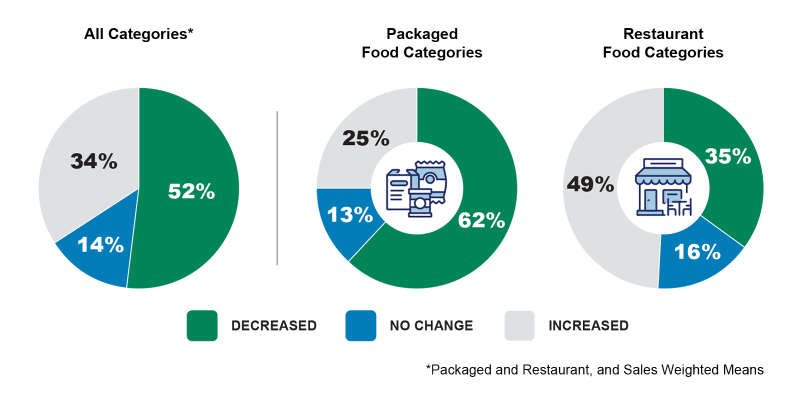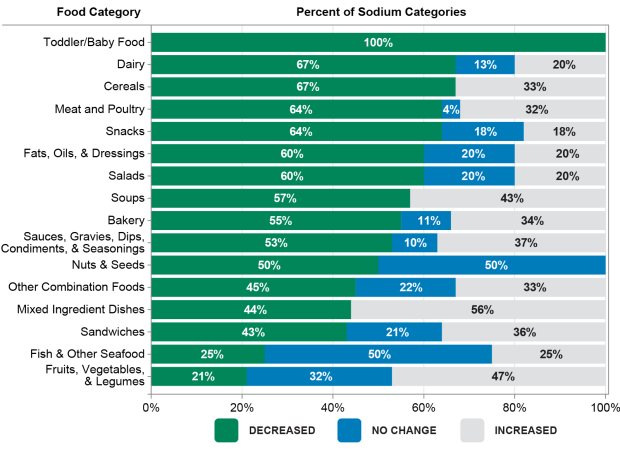Sodium Reduction in the US Food Supply 2010-2022
Sodium Reduction
The FDA recommends nutritious foods that support health and wellness. The US is facing a growing epidemic of preventable chronic diseases related to diet such as heart disease, type 2 diabetes and obesity. Improving nutrition offers one of the greatest opportunities to reduce these and other chronic diseases and premature deaths. Another way the FDA promotes healthy eating habits is by encouraging industry to make foods healthier, including reducing sodium content. Too much sodium can raise blood pressure, which is a major risk factor for heart disease and stroke.
More than 70 percent of the sodium people in the US eat comes from processed and processed foods, not from salt at home. It is difficult for consumers to reduce sodium intake because the level of sodium throughout the food supply is so high. By reducing sodium levels in the food supply, consumers will have more choices that can fit into a healthy diet.
To help address the public health problem of excessive sodium consumption, the FDA is taking a unique approach to setting voluntary dietary sodium reduction targets to help gradually reduce sodium in the food supply. This fact sheet covers a preliminary assessment of the progress of the first set of goals.
FDA Sodium Reduction Goals
In October 2021, the FDA published final guidance with voluntary sodium reduction targets to provide measurable goals for 2.5 years. The agency now refers to these as Phase I targets. Phase I targets were designed to support reducing average sodium intake from 3,400 milligrams/day (mg/day) to 3,000 mg / day and is based on data from 2010. Two and a half years from October 2021 to April 2024.
In August 2024, the FDA published the draft guidance Voluntary Sodium Reduction Goals: Targeted and Above-Included Sodium Effects in Commercially Processed, Packaged, and Prepared Foods (2nd Edition) with new goals of a 3-year initiative to reduce sodium in foods to be developed. progress has been made to reduce sodium in the food supply. The new goals, called Phase II, build on the goals of Phase I, which was issued in 2021.
FDA will consider comments on these provisions before issuing final guidance. The new goals, if met, would support reducing sodium intake to approximately 2,750 mg/day. Although this is higher than the recommended upper limit of 2,300 mg/day for ages 14 and older, the FDA is taking a step-by-step approach to achieving its sodium reduction goals. Moreover, even modest improvements across the population can produce significant public health benefits.
Preliminary Examination
Below is a preview of the progress being made toward meeting the Phase 1 targets outlined in the 2021 final guidance. FDA reviewed packaged food labels, sales and restaurant menu items from in 2022, the latest year for which data is available, using the same criteria outlined in the final guidance for 2021. We have not yet been able to fully assess progress against Phase 1 targets until relevant data from the 2.5 year period ending April 2024 is available. A formal review will be available once the FDA has reviewed the 2024 data. We expect greater progress on Phase I targets to be achieved once those data are available.
The results examining progress in dietary sodium reduction compared to 2010 (the base year used for Phase I sodium measurements) and 2022 (the latest date for which data were available) are encouraging and indicative. ‘a first look at progress in reducing sodium in the food supply. . Since some sub-sections were added or removed between 2010 and 2022 (due to available data), only comparable sub-sections were analyzed. For example, six packaged food categories in 2022 did not have a 2010 counterpart and 15 restaurant food categories did not have a 2010 counterpart in 2022. Overall, 40% of food groups had already achieved Phase I sodium targets or were within 10% of achieving targets.
Progress in Sodium Reduction for Packaged and Restaurant Food Categories (2010 to 2022)
|
Packaged Food Groups & Integrated Restaurants |
Packaged Food Groups |
Restaurant Food Groups |
|---|---|---|
|
More than 50% of the groups are reduced in sodium 34% of groups have increased sodium There was no change in 14% of the groups |
More than 60% of the categories have reduced sodium (of these, 30% have reduced more than 10%). 25% of the groups have increased sodium There was no change in 12% of the groups |
35% of the categories are reduced in sodium (of these, 40% are reduced by more than 10%). 49% of groups have increased sodium There was no change in 16% of the groups |
Note: ‘No change’ is defined as a difference in sales trends between 2010 and 2022 of less than plus or minus 2%.
More detailed progress on Phase One sodium reduction targets from 2022 across food categories is shown below. There are 16 major food groups with individual sodium targets for 163 small food groups because one method does not fit all; in 11 of the 16 food categories at least 50% of the food groups are reduced in sodium.
Progress in Sodium Reduction in Common Food Groups (2010 to 2022)
Of the major food groups represented below, some are made up of packaged foods (e.g. Baby Food), others are a combination of packaged and restaurant foods (e.g. sandwiches), ‘ and others include portions of food that cannot be compared due to omissions or additions. from 2010 to 2022 (e.g. Combined Containers do not include 4 units as installed in 2022). In addition, the number of components within each general food category varies as the sample size may not have been large enough to include data in 2010 or 2022.
FDA will continue to monitor sodium content in the food supply as data becomes available to evaluate further developments.
Decisions
This preliminary assessment shows progress in reducing sodium and meeting FDA Phase I targets between 2010 and 2022 in many food categories. Overall, 40% of the food groups had met the Phase I sodium targets or were within 10% of reaching the targets. We expect greater progress on the Phase 1 targets when the 2024 data becomes available. The FDA will conduct a more formal review at that time. The greatest amount of reduction was seen in packaged food categories. While many restaurant brands have shown a reduction, there may be a break in the trend as restaurants are able to find more ingredients with reduced sodium. Most importantly, as of 2022, manufacturers of some baby and children’s foods had lowered sodium content beyond Phase I targets.
#Sodium #Reduction #Food #Supply

